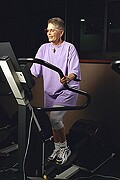
MONDAY, Aug. 27 (HealthDay News) — Staying physically fit in middle age makes it less likely that you’ll develop chronic diseases ranging from heart disease to certain cancers in old age, new research finds.
“Not only do the people with higher fitness live a little bit longer, the onset of chronic disease occurs even later, so that the amount of time you spend in your life with chronic diseases is compressed into a smaller period of time,” said senior study author Dr. Jarett Berry, an assistant professor of internal medicine at University of Texas Southwestern Medical Center, in Dallas.
For people who are unfit in middle age, the data suggest that even a modest increase in fitness could translate into fewer chronic conditions.
For the study, researchers examined information on nearly 19,000 men and women with a median age of 49 who were taking part in the Cooper Center Longitudinal Study, which has tracked the health of mostly white, healthy, well-educated participants since 1970.
Researchers matched up data from the Cooper Study with Medicare claims information starting when participants were 65. Follow-up occurred for a median of 26 years.
Participants’ fitness levels were divided into five quintiles, or fifths, based on how fast and how long they could run on a treadmill.
The most fit at midlife were less likely at age 70 and up to develop a host of chronic diseases, including Alzheimer’s disease, colon or lung cancer, congestive heart failure, chronic kidney disease, chronic obstructive pulmonary disease, type 2 diabetes and heart disease than the least fit.
Fitter patients were also somewhat more likely to live longer, and to spend more of those years free of chronic diseases or with fewer chronic diseases, the researchers said.
An analysis of about 2,400 people who died during the study found that fitter people had fewer chronic diseases during their last five years of life. The most fit spent about 50 percent less time with four or more chronic diseases than the lowest fitness group, and 34 percent more time with only one or no chronic disease.
The study is published online Aug. 27 in the Archives of Internal Medicine.
So what does it take for a middle aged man or woman to qualify for those upper quintiles for fitness?
Technically, the treadmill test measured METs, or metabolic equivalents, a unit that estimates the amount of oxygen used by the body during physical activity. The higher the METs, the greater a person’s fitness.
Roughly speaking, a middle-aged man who can run an 8-minute mile and a middle-aged woman who can run a 10-minute mile would fall into the upper quintile, or nearly the upper quintile, for fitness, Berry said.
For people who are out of shape at midlife, there’s good reason to get going with an exercise program, Berry said. Every single MET increase in fitness level was associated with a 6 percent decrease in the risk of chronic disease, according to the study. When a sedentary person starts a moderate-intensity exercise program, a one- to two-MET increase in physical fitness is “very doable,” he said.
In an accompanying editorial, Dr. Diane Bild, associate director of prevention and population sciences for the U.S. National Heart, Lung, and Blood Institute, said the study was unique in that it found a connection between fitness and delay of a range of chronic diseases.
“It gets to a goal which a lot of people express, which is to live a long, healthy life and die quickly,” Bild said.
Prior research has shown that physical fitness is associated with a lower risk of death, Bild said. Some researchers have questioned whether that meant physically fit people would just end up living more years with chronic disease. But this study suggests otherwise.
“There was a concern that people may live longer, but that they will live longer with disability,” Bild said. “This analysis suggests the people who are more fit delayed the onset of morbidity [disease], as well as delayed mortality.”
Still, she noted, the study was observational, meaning that while researchers found an association between physical fitness and delay of chronic disease, they didn’t prove that exercise or fitness was the cause.
It’s possible, for instance, that the same genes that enable a person to remain fit in middle age also confer longevity, she noted.
Current recommendations from U.S. health authorities recommend that adults get at least 2.5 hours of moderate aerobic activity each week.
More information
The U.S. National Heart, Lung, and Blood Institute has more on exercise.

